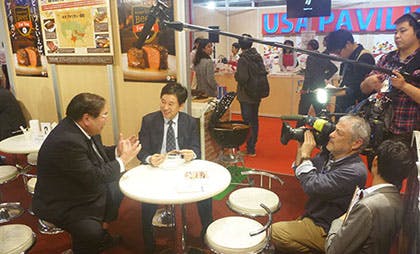U.S. Pork and Beef Showcased at Asia’s Largest Food Trade Show

A large crowd of visitors gathers at the USMEF booth during FOODEX Japan 2016
USMEF met with more than 300 buyers and representatives of Japan’s retail, foodservice and food distribution industries and handed out more than 1,600 samples of U.S. beef and pork at FOODEX Japan 2016. This annual exhibition attracts nearly 100,000 visitors to Japan’s Chiba prefecture, located in the Greater Tokyo Area. American barbecue, new restaurant menu concepts and thick cuts of U.S. beef and pork were highlighted by USMEF, which received funding support from the USDA Market Access Program (MAP), the Beef Checkoff Program and the Pork Checkoff.
U.S. red meat received notable publicity when TV Tokyo visited the USMEF booth to conduct interviews for the news program, “World Business Satellite.”
Throughout the event, buyers and food industry professionals from across Japan and several other key Asian markets stopped at the USMEF booth to learn about U.S. beef and pork and discuss global market conditions for red meat.
For the U.S. meat industry, FOODEX Japan is also an opportunity to learn what other meat-producing countries are doing.

American pork character Gochipo was popular during his appearances at FOODEX 2016
“FOODEX is the largest trade show in Asia and a very important opportunity for us to take a look at competitors’ products, including domestic items being marketed by Japanese companies,” said Philip Seng, USMEF president and CEO, who participated in this year’s show. “It’s really an important event for USMEF to position itself in the industry and examine our key Asian markets – not only as they stand today, but also what they could look like in the future.”
Both U.S. beef and pork exports to Japan declined in 2015, but there is optimism on both fronts. Larger supplies of U.S. beef will help the U.S. industry regain market share from Australia as its production decreases this year. Japan’s domestic beef production is also expected to decrease again this year, leaving more room for imports. The imported pork market remains fiercely competitive, but chilled U.S. pork has been recovering strongly following the West Coast port delays in the first quarter of 2015. In addition, the yen – which weakened significantly versus the U.S. dollar in 2015 – has rebounded to some degree this year. Longer-term prospects are also brighter due to the Trans-Pacific Partnership (TPP), which is expected to boost U.S. exports to Japan by reducing import tariffs.
Also promising is Japan’s recent surge in tourism – foreign visitors to Japan increased nearly 50 percent last year to about 20 million – which has made it an even more attractive target for food suppliers looking to capitalize on growth in Japan’s hotel and restaurant sectors. Japan is projecting tourism to further expand to about 30 million visitors per year by 2020, when Tokyo will host the Summer Olympics.

Takemichi Yamashoji (left), USMEF director in Japan, is interviewed by the TV show “World Business Satellite” at FOODEX
With this in mind, USMEF’s promotions at the 2016 version of FOODEX emphasized key phrases to promote U.S. beef and pork. “American Meat: enjoy at home, in restaurants and outdoors” focused on the versatility of U.S. red meat. USMEF used “eat at home” themes supplemented by U.S. beef samples, including thick-cut striploin steak, ribeye roll steak, beef stroganoff using chuck eye roll and Japanese-style stewed beef utilizing U.S. short plate.
Visitors were also offered copies of the “American Beef Promotion Guidebook,” which USMEF recently published for retailers.
“Retail industry visitors to this year’s FOODEX were interested in new merchandising styles and they were very interested and pleased with the USMEF guidebook,” explained Takemichi Yamashoji, USMEF director in Japan.
USMEF introduced the U.S. pork campaign, “Feast for Weekend,” at FOODEX, featuring the American pork character Gochipo. The Gochipo materials and a consumer package tray were very well-received by visitors. For the Japanese foodservice industry, USMEF promoted U.S. pork by distributing tasting samples such as seasoned spare ribs and honey-baked ham.
USMEF also prepared roast pork, which is registered as a “Recipe of Fame” at Cookpad, the largest recipe search engine in Japan, along with Chinese-style stewed pork and barbecue back ribs. A newly developed bonus item, a pork-and-vegatables dish made with tenderloin, was especially popular among FOODEX visitors.
